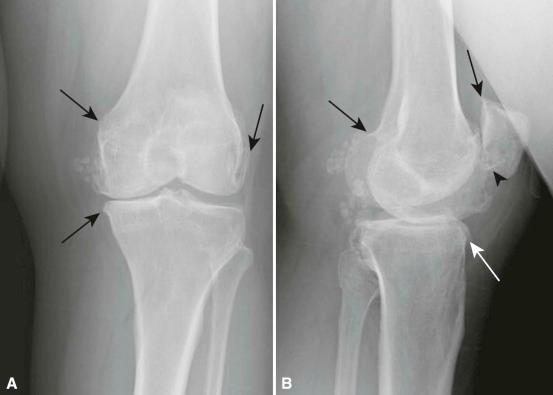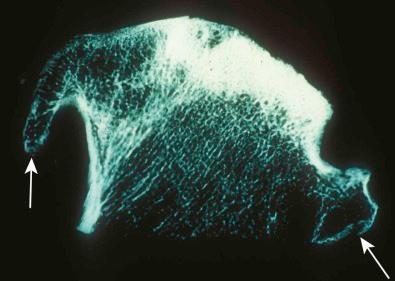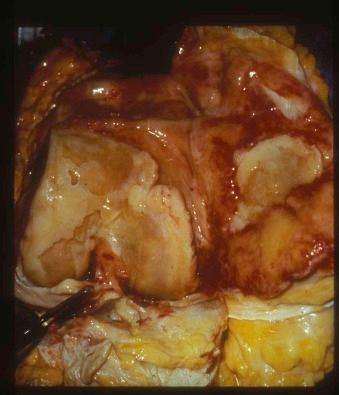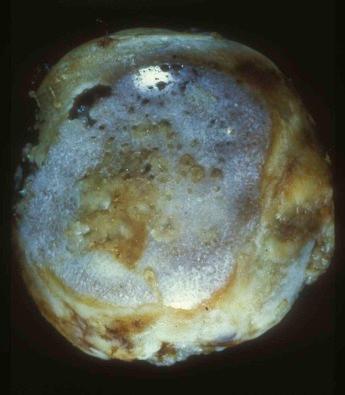Physical Address
304 North Cardinal St.
Dorchester Center, MA 02124
Bone morphogenetic protein (BMP): a member of a superfamily of proteins that promotes the formation of bone and the skeleton
Collagen IX: a fibrous protein that is a heterodimeric molecule expressed mainly in cartilage
Collagen X: the fibrous protein constituent of hypertrophic and mineralizing cartilage
Endochondral ossification: the process of bone development from cartilage seen during skeletal development of long bones and in reparative processes such as fracture and other forms of injury
Linkage analysis: a study to establish linkage between genes
Osteoarthritis: a degenerative joint disease
Pannus; the vascular synovial tissue covering an articular surface
Synovium: the thin layer of connective tissue lining joints and tendons
Osteoarthritis (OA) is the leading cause of musculoskeletal disability in the Western world and is the most common form of arthritis. This disease entity was originally defined by Sir Archibald E. Garrod in the 1890s. Based on anatomic features, Nicholas and Richardson in 1909 divided chronic osteoarthritis into two major categories: inflammatory types and noninflammatory or degenerative types. In common usage, however, OA is usually the term reserved for noninflammatory, degenerative conditions, and the inflammatory types are described as arthritis with a clinically descriptive prefix, such as rheumatoid arthritis. Using either nomenclature, two pathologic groups emerge: (1) disorders with primary changes in synovium and perichondrium and (2) disorders with primary degeneration of articular cartilage.
In the United States and in most other Western countries, OA is a very common joint disorder. The number of people affected with symptomatic OA in the United States has grown from 21 million to nearly 27 million due to the growing aging population and factors such as obesity. In adults 30 years of age or older, symptomatic disease in the knee and hip occurs in about 6% and 3%, respectively. OA typically affects the hand, foot, or knee of women older than 50 years of age and the hip of men older than 50 years of age. Both racial and ethnic differences have been described in the prevalence and pattern of OA.
OA is the outcome of a range of disorders that result in structural and functional failure of synovial joints. The clinical presentation of OA can be any one of the following:
Presentation limited to a single large joint (unilateral or bilateral), usually the knee or hip
A generalized process involving small joints such as the distal and proximal interphalangeal joints of hands, first carpometacarpal joint, knees, hips, and metatarsophalangeal joints
OA secondary to neurologic deficits such as Charcot joints (peripheral neuropathies due to diabetes, pernicious anemia, and spinal cord degeneration as seen in tabes dorsalis and syringomyelia)
A rarer form of erosive arthritis radiologically mimicking inflammatory arthritis and affecting the distal and proximal interphalangeal joints and occasionally large joints
The characteristic symptoms of OA include joint pain that is typically related to activity, stiffness of short duration, reduced function, and joint instability (buckling or giving away). Physical examination can reveal tenderness over the joint line; crepitus; restricted range of movement; pain on passive joint motion; instability; bony enlargement of the distal and proximal interphalangeal joints (Heberden and Bouchard nodes); and deformities such as bowed legs, altered gait, muscle atrophy, or weakness and joint effusion.
Conventional radiography is the most commonly used modality in the diagnosis of osteoarthritis. The most characteristic imaging finding is joint space narrowing. Other features visualized on conventional imaging include marginal osteophytes, increased bone density (subchondral sclerosis on both sides), and subchondral cysts or geodes ( Figs. 19-1A and B and 19-2 ). The presence of asymmetric narrowing of joint space, especially in large joints with the presence of osteophytes, is considered fairly specific for OA. Computed tomography (CT) is helpful in the assessment of facet joint OA of the spine and detection of intra-articular loose bodies. Magnetic resonance imaging (MRI) is seldom used in routine assessment or initial diagnosis of OA. However, MRI is well capable of detecting early changes and is uniquely able to depict all compartments of the joint, including the articular cartilage, menisci, intra-articular ligaments, synovium, capsular structures, bone contours, and bone marrow. This has aided in understanding the natural history of the disease and in guiding therapeutic interventions. Imaging modalities such as ultrasound play a role in assessing the synovitis associated with OA. One must keep in mind that the radiologic changes do not always reflect clinical symptoms and signs and progression of disease in these patients.


Gross changes in an arthritic joint reflect alterations in the shape, loss of integrity of cartilage matrix or support structures, and alterations in the mechanical properties of the joint tissue. Alterations in shape in OA are often due to the formation of osteophytes at the joint periphery and sometimes under the articular surface. Macroscopic changes in the cartilage surface are seen as fibrillation, erosion (ulceration), and cracking. Roughened, clefted areas in fibrillated cartilage replace the normal smooth cartilage surface. Progressive degenerative changes lead to erosion and denudation, thus exposing the underlying dense bone, a process called eburnation ( Figs. 19-3 and 19-4 ). Cracking is seen as deep clefting into the cartilage. Softening of the cartilage is called chondromalacia, and it may precede fibrillation. Osteophytes, bony or cartilaginous outgrowths, can be seen at the periphery of the joint. Subchondral bone is densely sclerotic due to increased osteoblastic activity. Loss of overlying articular cartilage allows synovial fluid to accumulate through bony defects within the marrow spaces, thus forming subchondral cysts or geodes. In addition, bone and cartilage fragments can separate and become incorporated into synovial fluid and proliferate as loose bodies. Synovium surrounding damaged joints tends to proliferate, to become hyperplastic, and to extend into the joint, thus forming a pannus.


Become a Clinical Tree membership for Full access and enjoy Unlimited articles
If you are a member. Log in here